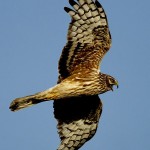
The article by Amy-Jane Beer in this month’s BBC Wildlife is certainly worth a read. It’s also worth a look – Laurie Campbell’s photographs are stunning.
You should buy the magazine to see the images and read the words – and there is plenty more to enjoy in the magazine’s pages of course.
The current Langholm study is mentioned – diversionary feeding of Hen Harriers has meant that losses of grouse to these magnificent birds have been negligible. The Langholm Head Gamekeeper, Simon Lester, even says as much in his quote ‘We can divert the Hen Harriers during the breeding season’. Hooray! Unfortunately, but not surprisingly (see page 210 of Fighting for Birds) he now has a Buzzard in his bonnet. There has to be some bird of prey that is ‘the problem’ and now it’s going to be the Buzzard. The BBC Wildlife article, interestingly, says that cameras on 12 Buzzard nests over 2 years have recorded 32 Red Grouse – that’s 16 a year from a moor which would expect to shoot hundreds in a day’s shooting. Doesn’t sound like much of a problem to me.
The article also alludes to the radio-tracking study of Hen Harriers and the fact that a radio-tagged Hen Harrier from Langholm disappeared in northern England. Well, in the midst of life we are in death, but it is surely time that we learn what the results of the long, long, long-running publicly-funded Hen Harrier radio-tracking study actually are. Back in the uncowed days of 2008, Natural England were writing that they were looking into the disappearance of Hen Harriers at roosts and northern England grouse moors which had been disclosed by satellite-tracking. Six years later we still haven’t seen those and subsequent data in the public domain. We do know of the fate of Bowland Betty at least.
Remember that 10 August is Hen Harrier Day.
Now, I must go back and read some of the other articles in BBC Wildlife.
[registration_form]
Laurie Campbells photos are always great and these are no exception, the article however interesting does not really spell out the problems nor the solutions for me.
Hen harriers are essentially extinct as breeders in the grouse moor areas of the UK, England should and could hold 300+ pairs. The achievement of this extinction appears to be down to persecution, there is certainly no natural explanation, So:- 1 persecution cannot be or have been carried out by a few rogues within the grouse industry it is and has been widespread, endemic and almost certainly organised.
2 what data there is shows that without off moor peregrines that they too would be in the same sorry state.
We need solutions, it is quite clear that solutions exist and yet the much anticipated DEFRA/ NE emergency recovery plan for harriers has as yet not materialised because the shooting industry and conservationists cannot find consensus? Data quite clearly shows that harriers are not the anathema on grouse moors they are claimed to be:- using grouse density data supplied by the Moorland Association it has been shown that for every 5000acres of grouse moor there could ( should?) be two pairs of harriers without a measurable change to the grouse numbers harvestable. Yet all we hear from the MA and other parties from the industry is about supplementary feeding and brood management as soon as any birds appear and might nest. Given that huge areas of northern England grouse moors are designated SPAs for harriers and peregrines yet contain none perhaps to focus these peoples attention grouse shooting should be suspended until the appropriate numbers of harriers and peregrines are breeding successfully and subsidy payments to these moors cancelled.
Then again as Mark said in his 100 words there are a number of other issues that need to be addressed about CO2 absorption, water quality, flooding and biodiversity, given all of this we ought to change the emphasis of management of our uplands whatever the Tim Baynes of this world say.
Buzzards took 1.35 Red Grouse a year!!! Old cooks not worth a dime pushing young cooks into ether smaller territories! All Red Grouse moor keepers need to be sacked and asked to reapply for their jobs showing the birds of prey they support on the land such as Hen Harrier, Peregrine Falcon, Golden Eagle and Goshawk. How many would get their job back!!!
John – that’s your 400th comment on this blog. Thank you for them.
Anyone can of course share their views on hen harriers by writing to BBC Wildlife Magazine’s letters pages: [email protected]
We’re close to finishing work on the June issue, but there will be space in the letters pages from the July issue onwards
And we do have a fledgling Forum, just launched, which is a good place to air views or debate things printed in the magazine: http://www.discoverwildlife.com/forum